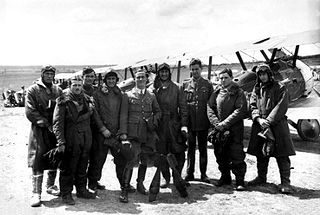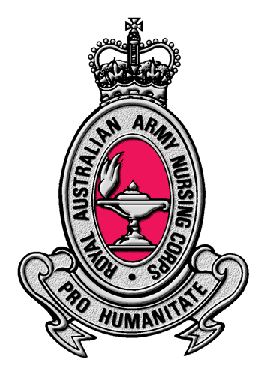
The Australian Army is the principal land warfare force of Australia, a part of the Australian Defence Force (ADF) along with the Royal Australian Navy and the Royal Australian Air Force. The Army is commanded by the Chief of Army (CA), who is subordinate to the Chief of the Defence Force (CDF) who commands the ADF. The CA is also directly responsible to the Minister for Defence, with the Department of Defence administering the ADF and the Army.

General Sir John Monash, was an Australian civil engineer and military commander of the First World War. He commanded the 13th Infantry Brigade before the war and then, shortly after its outbreak, became commander of the 4th Brigade in Egypt, with whom he took part in the Gallipoli campaign. In July 1916 he took charge of the newly raised 3rd Division in northwestern France and in May 1918 became commander of the Australian Corps, at the time the largest corps on the Western Front. Monash is considered one of the best Allied generals of the First World War and the most famous commander in Australian history.
The British Expeditionary Force (BEF) was the six-divisions the British Army sent to the Western Front during the First World War. Planning for a British Expeditionary Force began with the 1906–1912 Haldane Reforms of the British Army carried out by the Secretary of State for War Richard Haldane following the Second Boer War (1899–1902).

The First Australian Imperial Force was the main expeditionary force of the Australian Army during the First World War. It was formed as the Australian Imperial Force (AIF) following Britain's declaration of war on Germany on 15 August 1914, with an initial strength of one infantry division and one light horse brigade. The infantry division subsequently fought at Gallipoli between April and December 1915, with a newly raised second division, as well as three light horse brigades, reinforcing the committed units.

Field Marshal William Riddell Birdwood, 1st Baron Birdwood, was a British Army officer. He saw active service in the Second Boer War on the staff of Lord Kitchener. He saw action again in the First World War as commander of the Australian and New Zealand Army Corps during the Gallipoli Campaign in 1915, leading the landings on the peninsula and then the evacuation later in the year, before becoming commander-in-chief of the Fifth Army on the Western Front during the closing stages of the war. He went on to be general officer commanding the Northern Army in India in 1920 and Commander-in-Chief, India, in 1925.

The Australian Flying Corps (AFC) was the branch of the Australian Army responsible for operating aircraft during World War I, and the forerunner of the Royal Australian Air Force (RAAF). The AFC was established in 1912, though it was not until 1914 that it began flight training.

A field ration is a type of prepackaged military ration designed to be easily and quickly prepared and consumed in the field, in combat, at the front line, or where eating facilities are otherwise unavailable. Field rations are primarily used by military forces, though they are also sometimes distributed to civilians as part of humanitarian aid and emergency management. They differ from garrison rations and field kitchen provisions, which are intended for where proper meals can be supplied and prepared with relative ease and safety, such as in the rear where logistics are steady and fresh food can be supplied. They are similar to, but distinct from, other purpose-designed long-lasting types of food or rations such as emergency rations, humanitarian daily rations, and camping food.

A garrison ration is a type of military ration. Usually distinct from field rations, the term has varying meanings, but generally refers to either rations issued to personnel at a camp, installation, or other garrison; allowance allotted to personnel to purchase goods or rations sold in a garrison; the rations purchased with the aforementioned allowance; or a type of issued ration.

Unit colour patches are a method of identification used by the Australian Army, used to indicate which unit a soldier belongs to.
The 4th Brigade is a brigade-level formation of the Australian Army. Originally formed in 1912 as a Militia formation, the brigade was re-raised for service during World War I, elements of the brigade served at Gallipoli and in the trenches on the Western Front before being disbanded in 1919. In 1921, the brigade was re-raised as a unit of Australia's part-time military forces, based in the state of Victoria. During World War II the brigade served in the New Guinea and New Britain campaigns. Following the war, the brigade formed part of the 3rd Division, however, it was later reallocated to the 2nd Division, where it serves as a Reserve combined-arms formation including units and personnel from all corps of the Army including armoured, infantry, artillery, engineers, signals and ordnance.
David Murray Horner, is an Australian military historian and academic.

The Australian Intelligence Corps (AUSTINT) is a corps within the Australian Army. It was formed on 6 December 1907 and provides intelligence personnel in every formation headquarters in the Army. As of 2007, the corps consisted of "169 officers and 232 other ranks".

The Royal Australian Army Nursing Corps (RAANC) is a Corps of the Australian Army. It was formed in February 1951 from the Royal Australian Army Nursing Service. A Corps Badge was introduced in 1951 with the motto Pro Humanitate. It embraces the values of compassion and service to others, reflecting the care and dedication provided to the wounded and sick. Approval for the Corps flag was granted on 7 February 1958.

The Combat Ration One Man (CR1M) is a self-contained individual field ration in lightweight packaging procured by the Australian Defence Force for use in combat or other field conditions where organised food facilities are unavailable.

Military rations, operational rations, or military provisions are goods issued to sustain the needs of military personnel. As their name suggests, military rations have historically been, and often still are, subject to rationing, with each individual receiving specific amounts from available supplies. Military-issued goods and the rationing of such goods has existed since the beginnings of organized warfare.

The 6th Cavalry Brigade was a militia or Citizens Military Force (CMF) formation of the Australian Army based in South Australia. It originated from the 6th Light Horse Brigade and was later converted to the 6th Motor Brigade and eventually to the 6th Armoured Brigade. During World War II, the brigade undertook defensive garrison duties until its conversion to the armoured role in 1942. It did not see combat.

Lieutenant General Sir Alwyn Ragnar Garrett, KBE, CB was a senior commander in the Australian Army. He served as Chief of the General Staff (CGS) from 1958 to 1960.

Jeffrey Guy Grey was an Australian military historian. He wrote two volumes of The Official History of Australia's Involvement in Southeast Asian Conflicts 1948–1975, and several other high-profile works on Australia's military history. He was the first non-American to become the president of the Society for Military History, but is perhaps best known as the author of A Military History of Australia.















